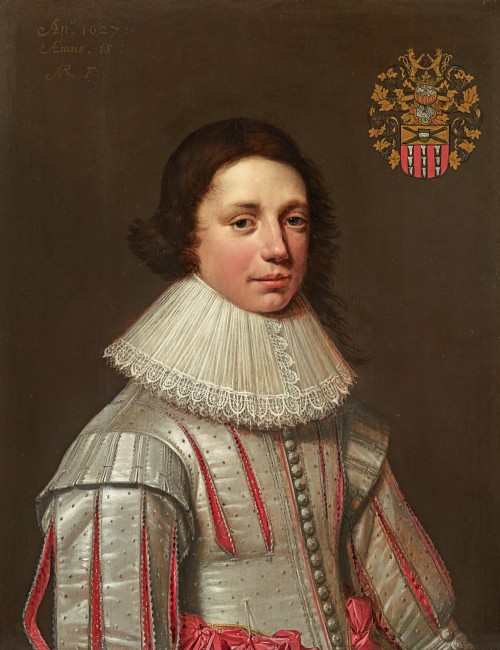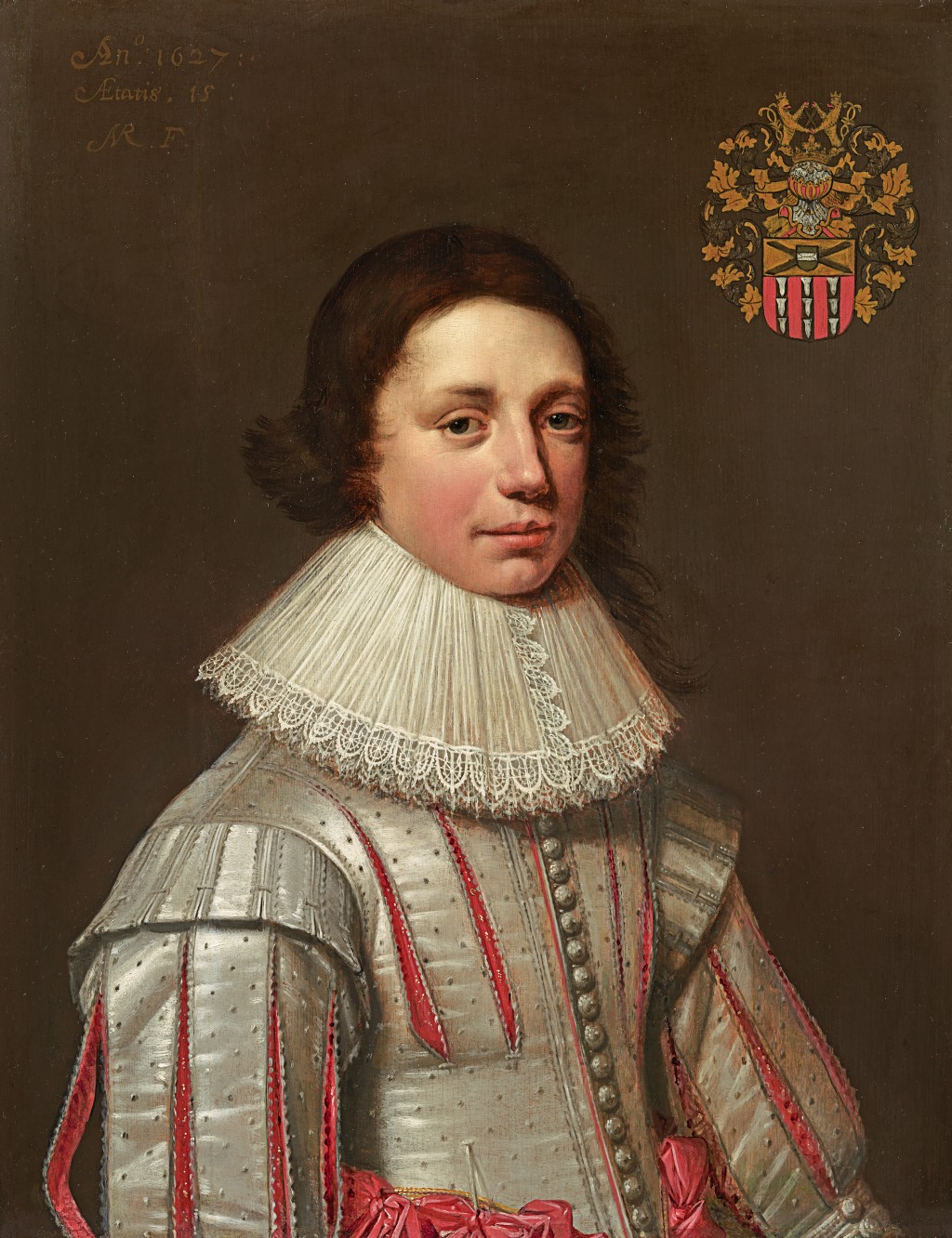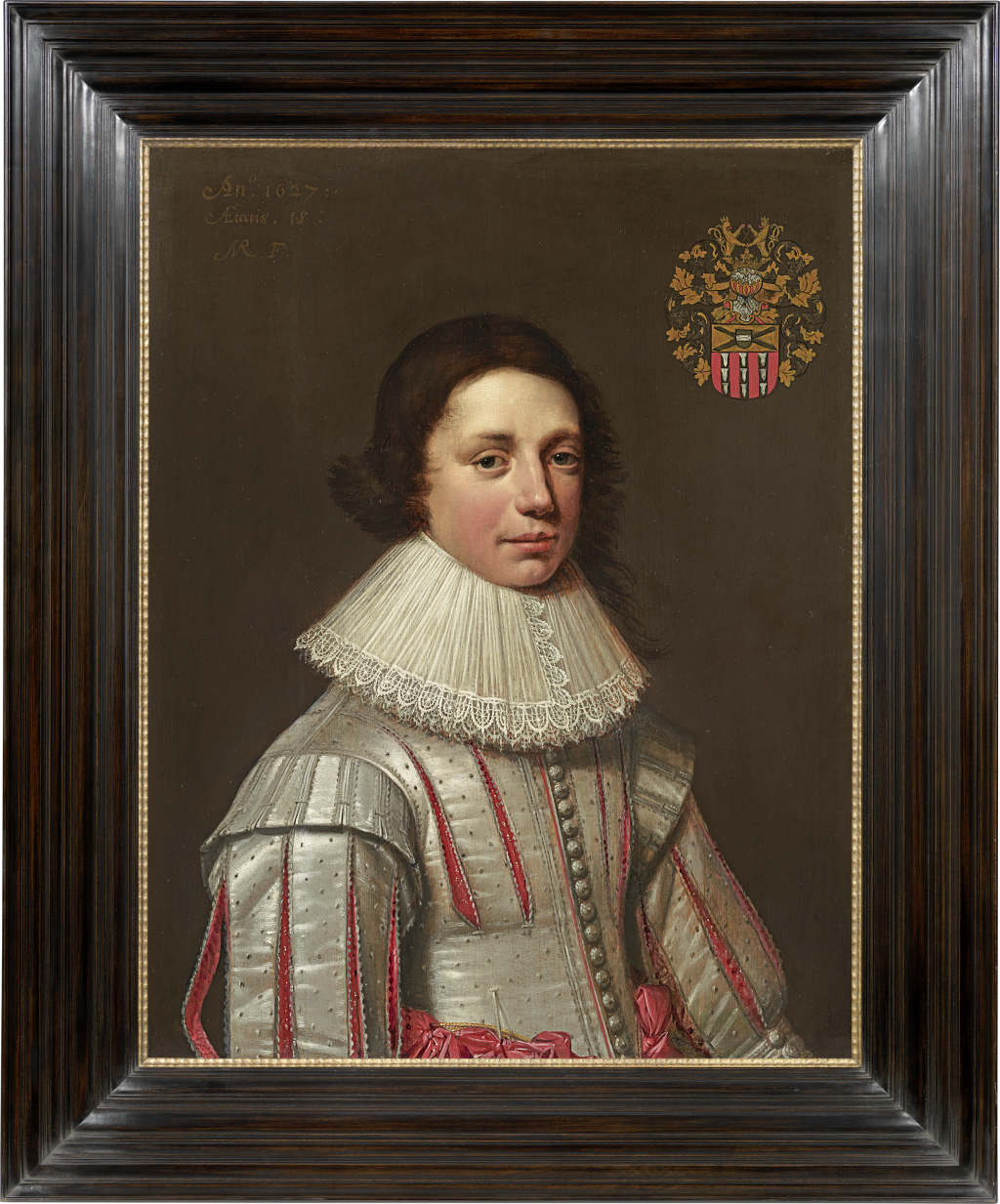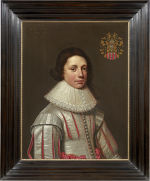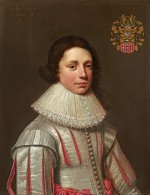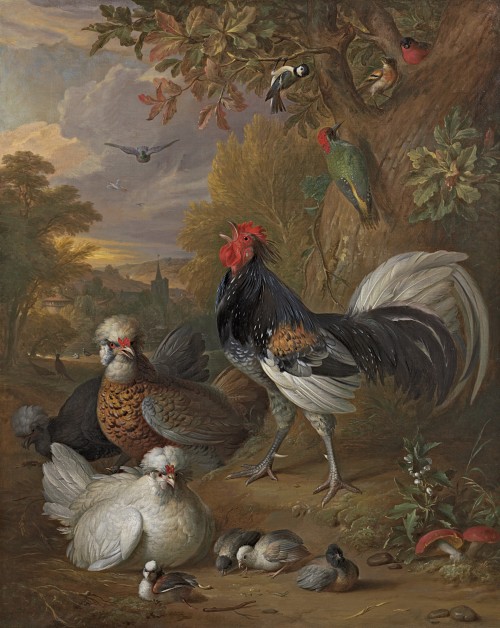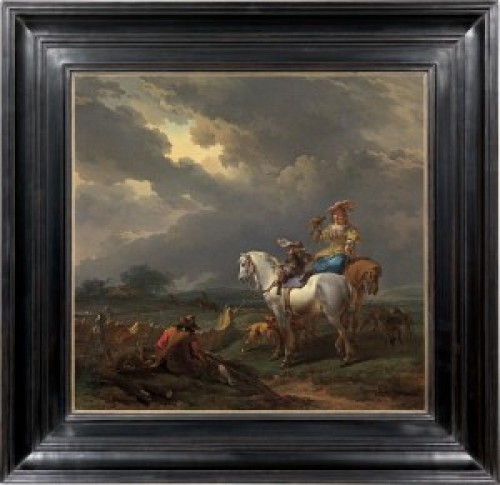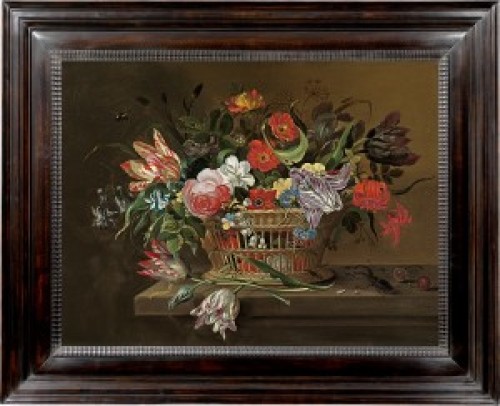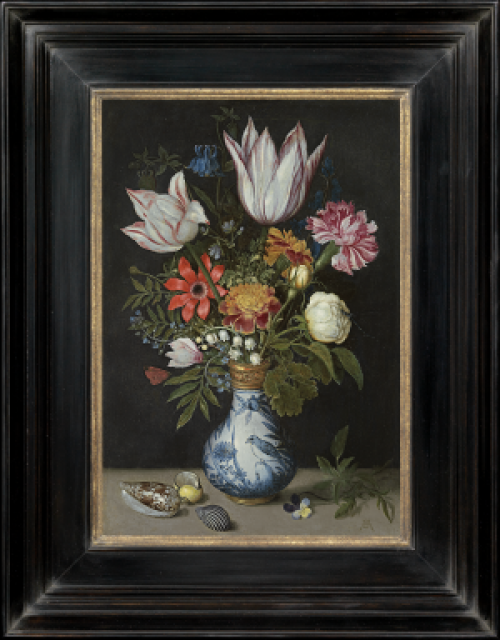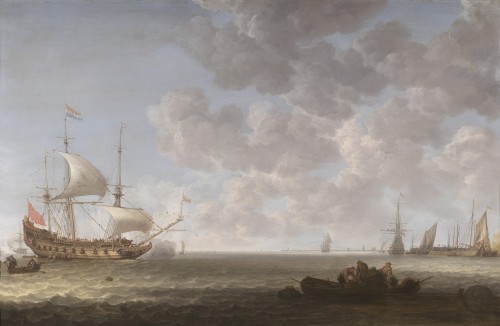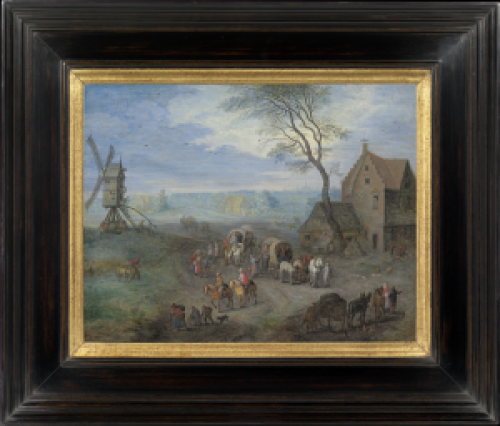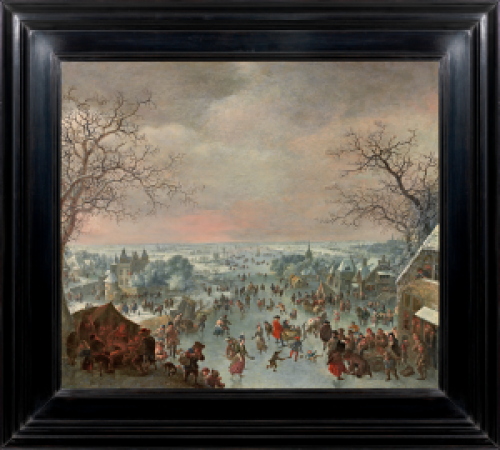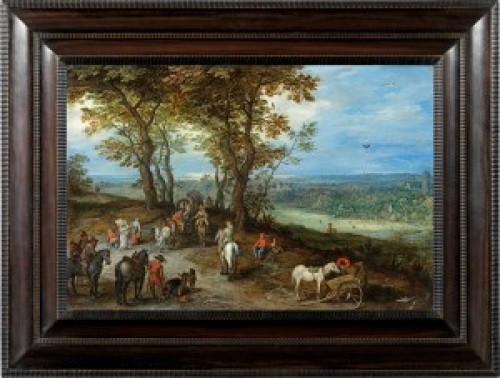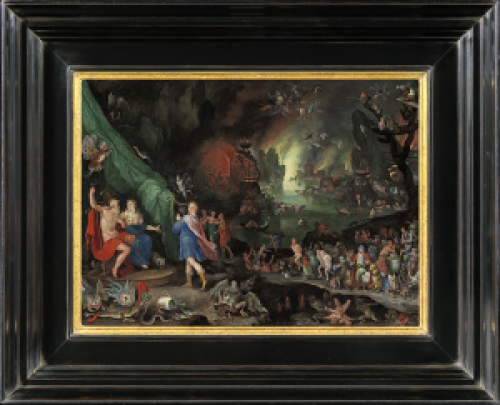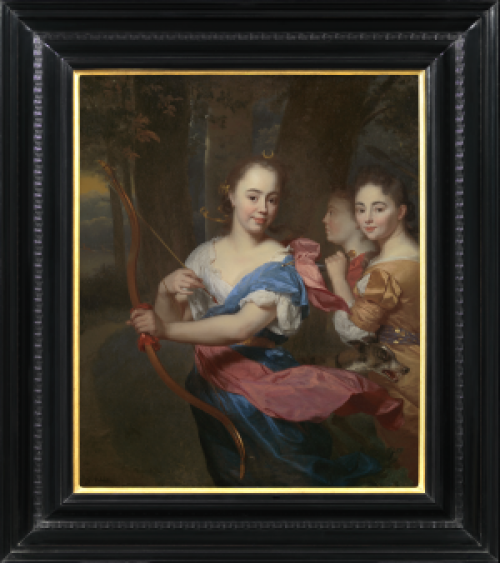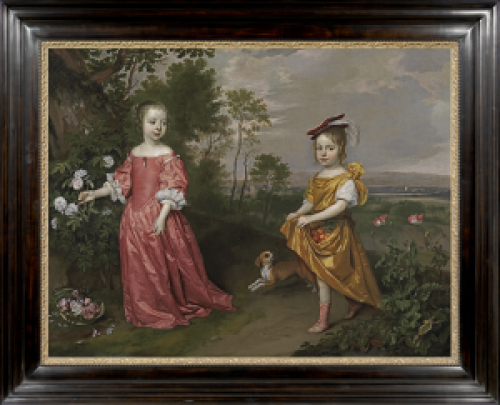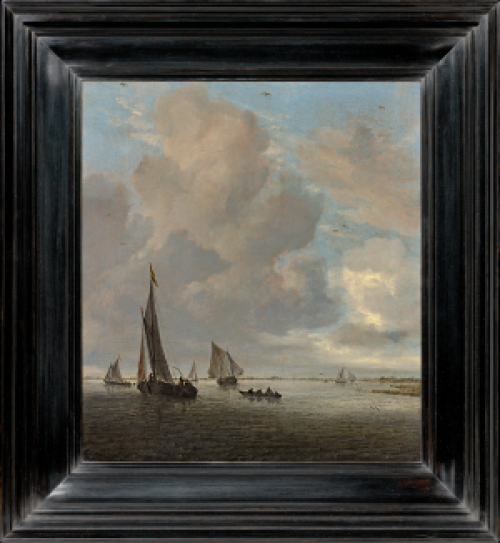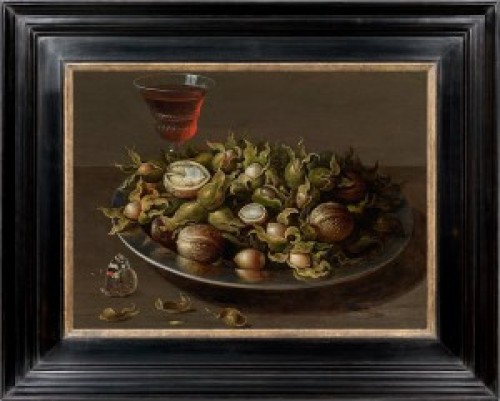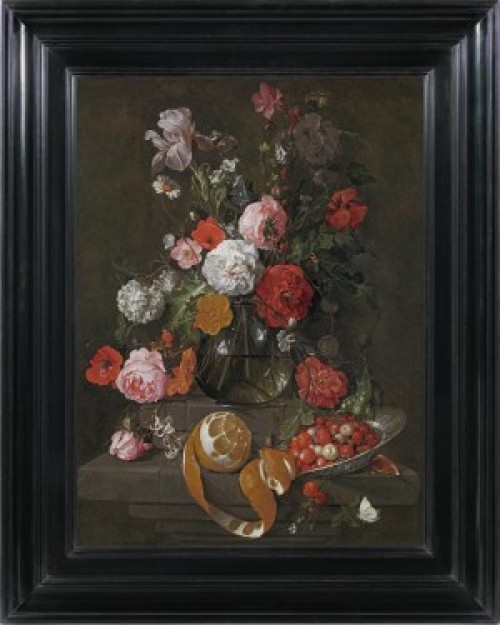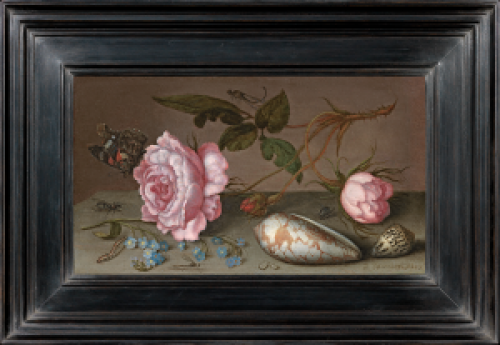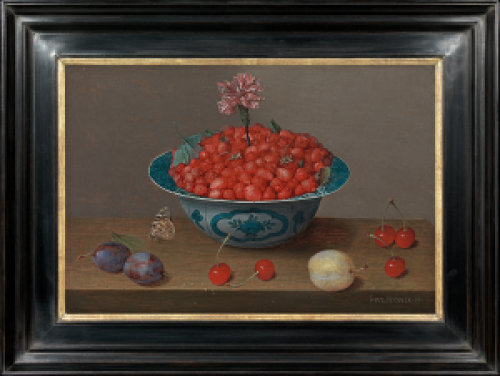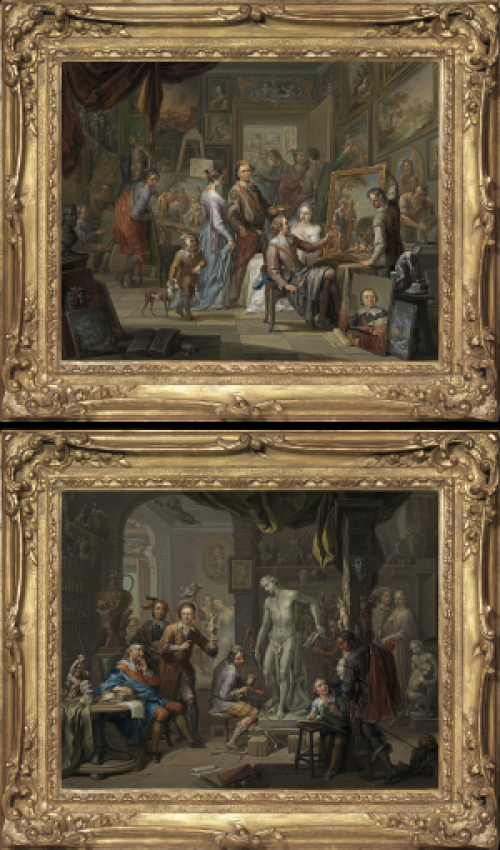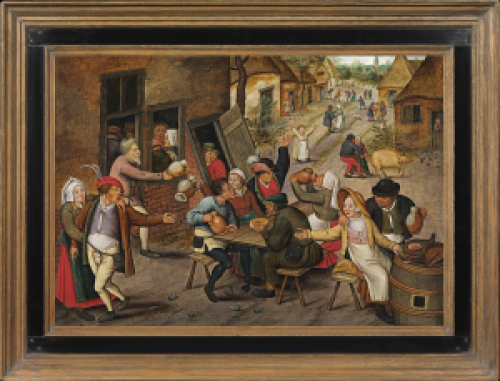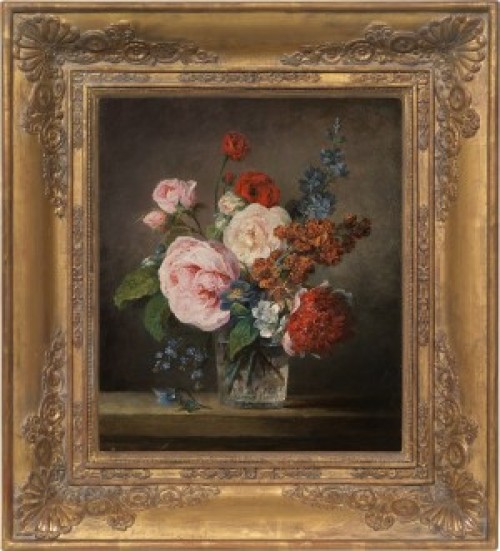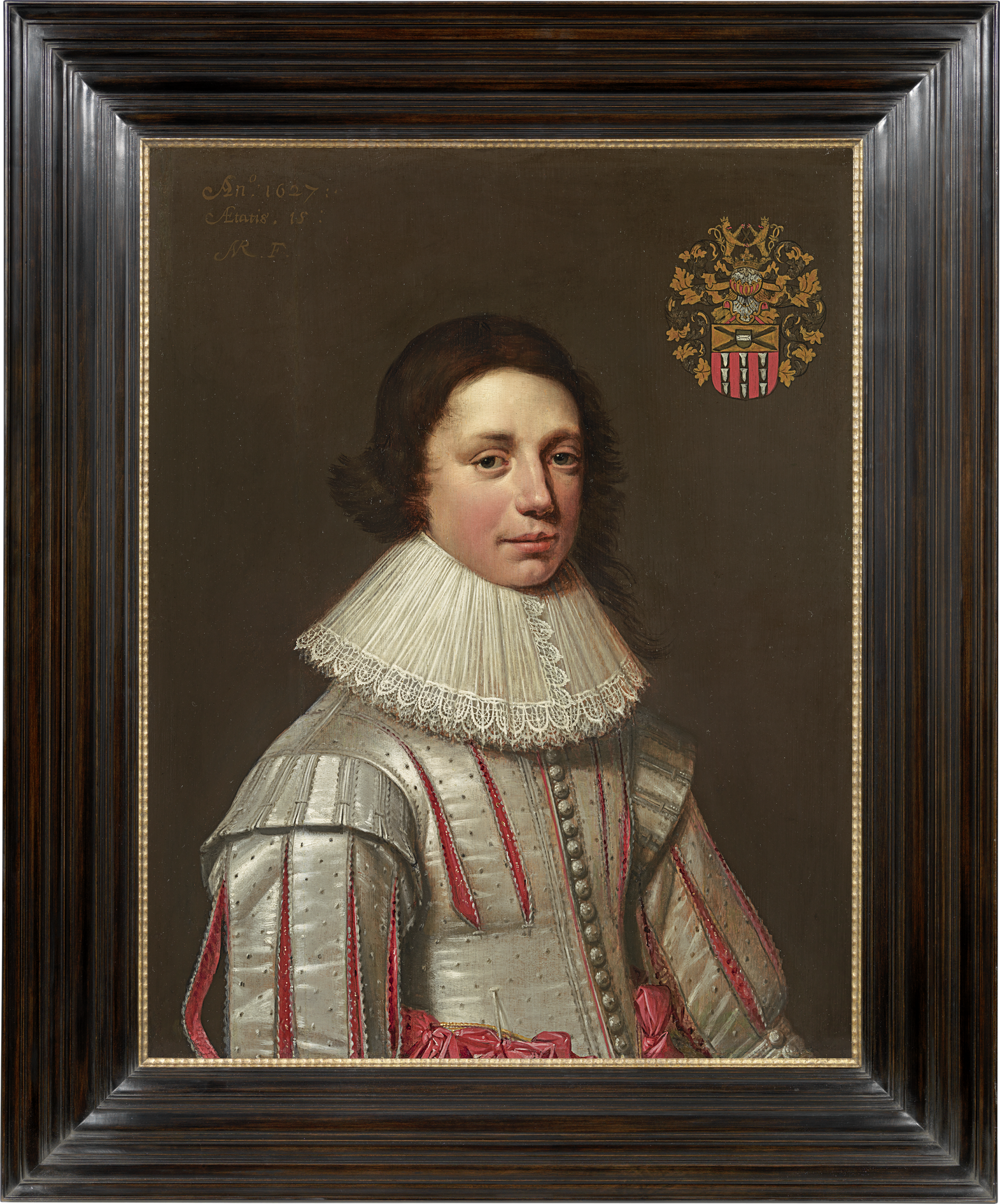ANTHONIE VAN RAVESTEYN
1580 – The Hague - 1669
Ref: CB 134
Portrait of Willem van der Wiele van de Werve (1612-1654), aged fifteen
Signed, inscribed and dated upper left: Ano 1627 / Aetatis 15 / AR F.
Oil on panel: 26 ¼ x 20 3/8 in / 66.7 x 51.8 cm
Frame size: 34 x 27 ½ in / 86.4 x 69.8 cm
Provenance:
Major John Edward Montague Bradish-Ellames, 8th Hussars (1895-1984);
by inheritance in a private collection, UK
A previously unknown monogrammed 1627 portrait by Hague painter Anthonie van
Ravesteyn surfaced recently.1 According to the inscription, the sitter is a fifteen-year-old boy and
the upper right coat of arms refers to the Stalpaert van der Wiele family. The boy is depicted
against a plain brown background but stands out because of his light costume: a silver buis
(doublet) with red decorative details. The painting is a characteristic work by the artist
Anthonie van Ravesteyn (c.1580-1669), of whom only a few monogrammed works are
known; several other closely related paintings are attributed to him. Remarkably, almost all of
the portraits signed by Ravesteyn or attributable to him with certainty have a connection with
the Stalpaert van der Wiele family.2 As the archival records make it evident that the artist was
active as a painter throughout his life and even held a prominent position, for example as Dean
of the painters’ guild, we may firmly conclude that the artist mainly worked in the studio of
his older brother, the successful portraitist Jan Anthonisz. van Ravesteyn (c.1572-1657), and
only signed his own works when there existed a personal relationship between him and his
subject. We will return to this later in this report.
At present, no fewer than eight portraits by the hand of Anthonie van Ravesteyn are currently
known, which are related to the Stalpaert van der Wiele family with certainty or probability.3
Five of them feature the monogram of Anthonie van Ravesteyn. One is dated 1623, four are
dated 1627, one 1628 and another 1629. The eighth piece is undated. In order to assess the
possibility of identifying the individuals represented, we must first examine the rather
complicated genealogy of this family in the sixteenth and seventeenth centuries, which was
partly Calvinist and partly Roman Catholic and included mayors of The Hague as well as Catholic priests. Johannes Baptist Stalpart van der Wielen (1579-1630), a renowned poet and
a parish priest in Delft, was the best-known member of the family.4 He was a full cousin of
The Hague mayor Pieter Stalpart van der Wielen (1597-1660), who was portrayed with his
entire family by painter Jan Mijtens in 1645.5
These boys and young men portrayed by Anthonie van Ravesteyn, however, belong to an
entirely different branch of the family, which in the seventeenth century no longer went by the
name Stalpaert van der Wiele but by Van der Wiele van de Werve. This is evident from the
heraldic shields, on which the coat of arms of the Stalpaert van der Wiele family is combined
with an inescutcheon of the Ruychrok van de Werve family. Based on his coat of arms, the
man portrayed at 77 years of age by Anthonie van Ravesteyn in 1623, has been identified as
Johan Stalpaert van der Wiele, who had been married to Elisabeth Ruychrok van de Werve.6
Elisabeth had inherited the manor Te Werve in Rijswijk near The Hague and a part of the
manor Grijsoord on the Southern islands of Holland.7 When she died in 1593, her husband
took over Te Werve, as their son Jacob van der Wiele van de Werve (1581-1642) was still a
minor. In 1606, he married Adriana Hanneman (c.1579-1665). They lived at the manor The
Werve in Rijswijk, of which only a small section of the original building still remains and
which was otherwise completely replaced by a later built structure. Since the family was
Catholic and public practice of the Catholic faith was forbidden during the seventeenth
century, Te Werve became a refuge for Catholics from Rijswijk and the surrounding area and
many Catholics gathered there secretly to attend mass. Thereby, the second cousin Johannes
Baptistus Stalpart van der Wielen, who was parish priest in Delft, occasionally acted as priest.
No portraits are known of Jacob van der Wiele van de Werve and his wife but they must have
been the patrons for the portraits of the young men and girls painted by Anthonie van
Ravesteyn during the years 1627-1629. An attempt has been made to identify them using the
dates and age inscriptions on the paintings.8 We do not know the names of the two eldest
sons, as they apparently died before their father’s death. According to the inscription on the
monogrammed painting in the Statens Museum for Kunst in Copenhagen, the eldest son was
nineteen years old when he was portrayed in 1627. A second, qualitatively equivalent, version
of his portrait, also by Anthonie van Ravesteyn, is kept in the Herzog Anton Ulrich-Museum,
which states that the sitter was born on 23 February 1608 and died on 19 October 1628. This
copy by the artist’s own hand may have been executed shortly after the sitter’s death in 1628.
The second son is the young man depicted in the portrait, also dated 1627, which was last sold
at auction by Dorotheum in Vienna in 2012.9 He was seventeen at the time and probably died
unmarried before 1642. Another, two years younger, is the fifteen-year-old in the portrait from
the same year, currently at Richard Green. He must have been born in or around 1612. A
portrait of one of the daughters is dated 1629 and inscribed with an age indication of fourteen.
Her effigy is now in the Herzog Anton Ulrich-Museum with the repetition of the eldest son’s
portrait. It has not yet been established which of the daughters is represented, since no years of birth are mentioned in the available sources.
In this respect, we are more fortunate with regard to the identification of the boy who was fifteen years old in 1627, because this age exactly matches that of the son who eventually inherited The Werve, Willem, who in 1633 declared being twenty-one years of age on the occasion of his marriage with the Amsterdamer Elisabeth Poppen. This allows us to identify the sitter of the portrait as Willem van der Wiele van de Werve, also simply known as Willem van de Werve, who inherited his father’s manor after his death in 1642 and died twelve years later, in 1654. He left two daughters, the eldest of whom inherited the house.
It was mentioned above that there may be an explanation for the fact that Anthonie van
Ravesteyn stepped out of the anonymity of his brother’s workshop precisely for this portrait
series. The mother of the depicted children and the daughter-in-law of the Johan Stalpaert van
der Wiele portrayed in 1623 was Adriana Hanneman (c.1579-1665), a sister of Jan
Hanneman, who was the father of the artist Adriaen Hanneman (1604-1671).10 The fifteen-year-old Adriaen Hanneman had been apprenticed to Anthonie van Ravesteyn in 1619 and was still
too young in 1623 to paint the portrait of Johan Stalpaert van der Wiele, his aunt’s father-in-law,
which explains that it was commissioned to his teacher. When the portraits of his Van
der Wiele van der Werve cousins were painted in 1627 and subsequent years, Adriaen
Hanneman, although old enough, had already left The Hague the year before and had settled
in London. His teacher Anthonie van Ravesteyn was the perfect candidate, as the family was
already well-acquainted with the artist.
30 August 2023
DOEK ART
(Claire van den Donk & Rudi Ekkart)
1 Oil on panel, 66.5 x 51.5 cm. Inscribed and signed upper left: Ano. 1627: / Ætatis. 15: AVR.F.
2 Regarding the signed and dated (1628) portrait of a dead child, nothing is known about the child’s identity. See: REO Ekkart, ‘De ontwikkeling van het Nederlandse doodsportret in de 16de en 17de eeuw’, in: BC Sliggers (ed), cat. exh. Naar het lijk. Het Nederlandse doodsportret 1500-heden, Haarlem (Teylers Museum) 1998, pp. 80-81.
3 In the sales catalogue of Old Master Paintings, Sotheby’s, London, 5th April 2023, lot 4, three other paintings were mentioned in addition to the work discussed here. The catalogue entry rightly mentioned the name of Johan Stalpart van der Wiele for the 1623-dated piece from the Haags Historisch Museum but then created serious confusion by claiming the sitter to be the well-known Catholic theologian and poet of this name. However, this Johan Baptist Stalpart van der Wiele (1579-1630) was the son of a nephew of the man portrayed by Anthonie van Ravesteyn in 1623.
4 BA Mensink, Jan Baptist Stalpart van der Wiele, advocaat, priester en zielzorger 1579-1630, Nijmegen 1958.
5 Haags Historisch Museum. See: AN Bauer, Jan Mijtens (1613/14-1670). Leben und Werk, Petersberg 2006, pp.240-242, no.A 118.
6 P Beelaerts van Blokland, ‘Drie weinig bekende portretten Stalpert van der Wiele’, Jaarboek Die Haghe 1935, pp.57-60.
7 FA Hoefer, ‘Het Huis te Werve bij Rijswijk’, De Navorscher 1893, pp.275-295.
8 Two portraits of girls do not feature age inscriptions and are therefore left unmentioned here.
9 Dorotheum, Vienna, 18th April 2012, lot 510. Earlier: Dorotheum, Vienna, 14th October 1997, lot 3.
10 O ter Kuile, Adriaen Hanneman 1604-1671, een Haags portretschilder, Alphen aan den Rijn 1976, pp.10 and 52-53; REO Ekkart, ‘De portretten van Willem Hanneman en Maria van Bodegom’, De Nederlandsche Leeuw 123 (2006), col. 94-96.
Abraham de Haen, Huis te Werve, Rijswijk, 1726. Private collection.
The house was inherited by Willem van der Wiele van de Werve in 1642.

